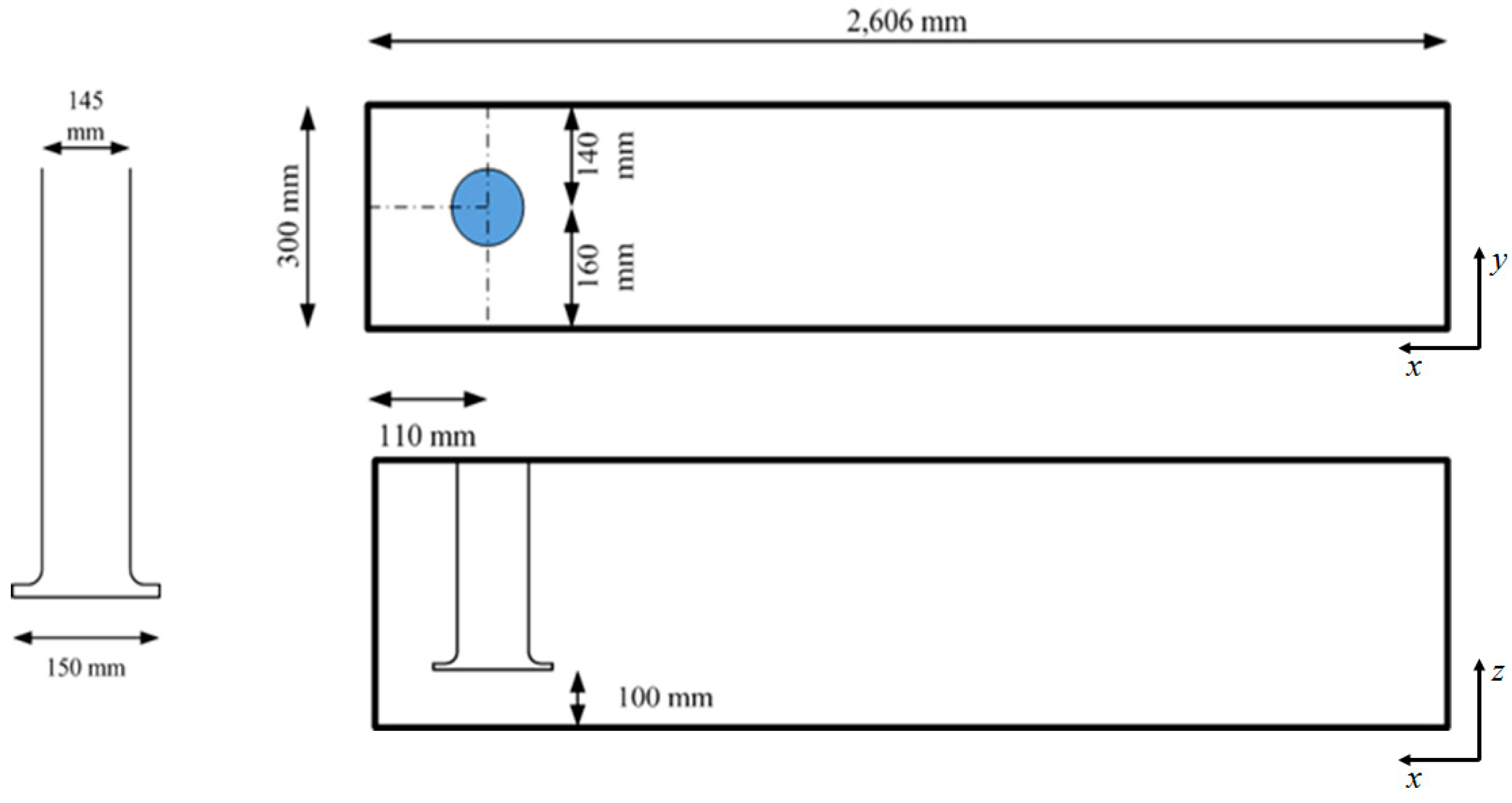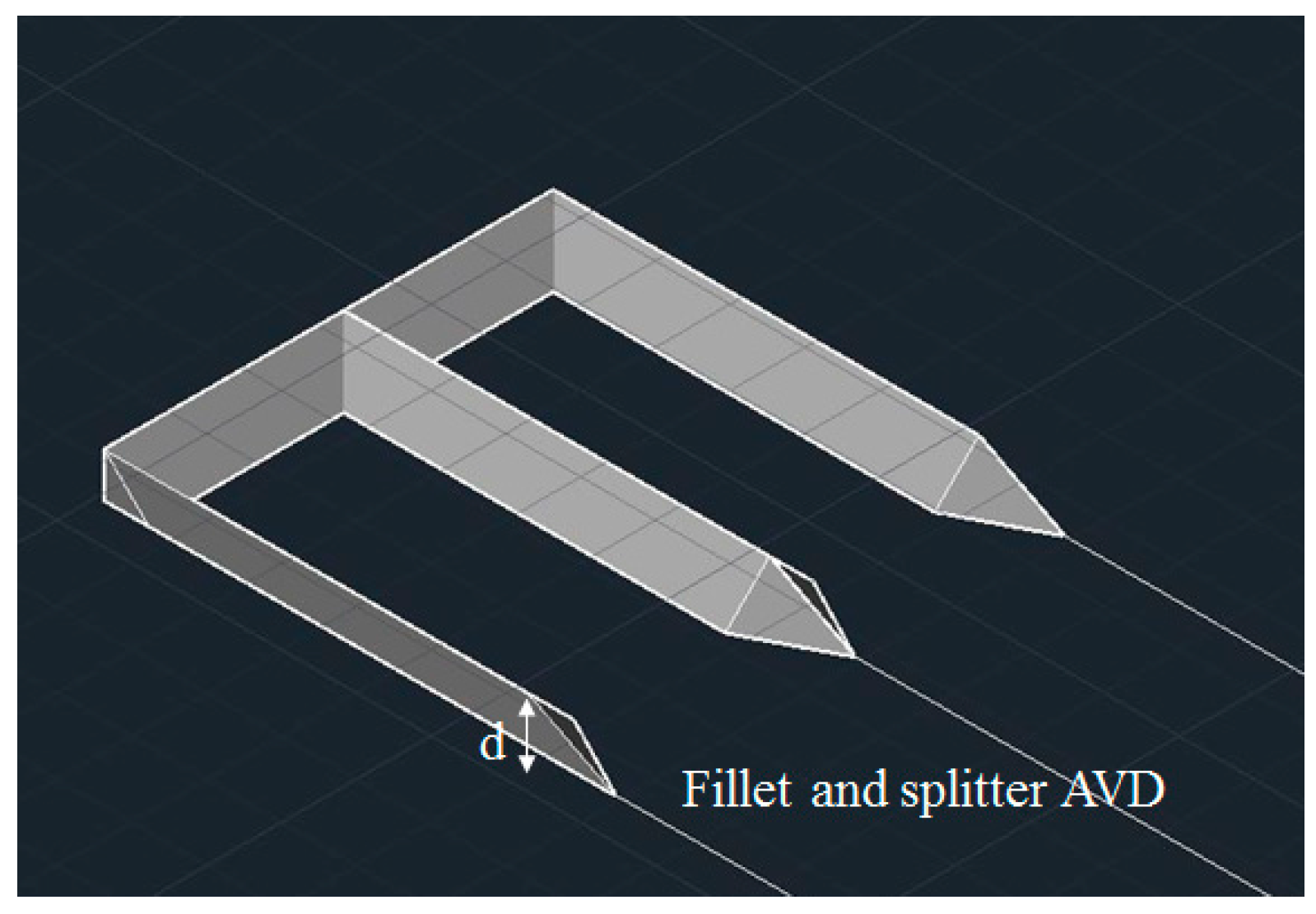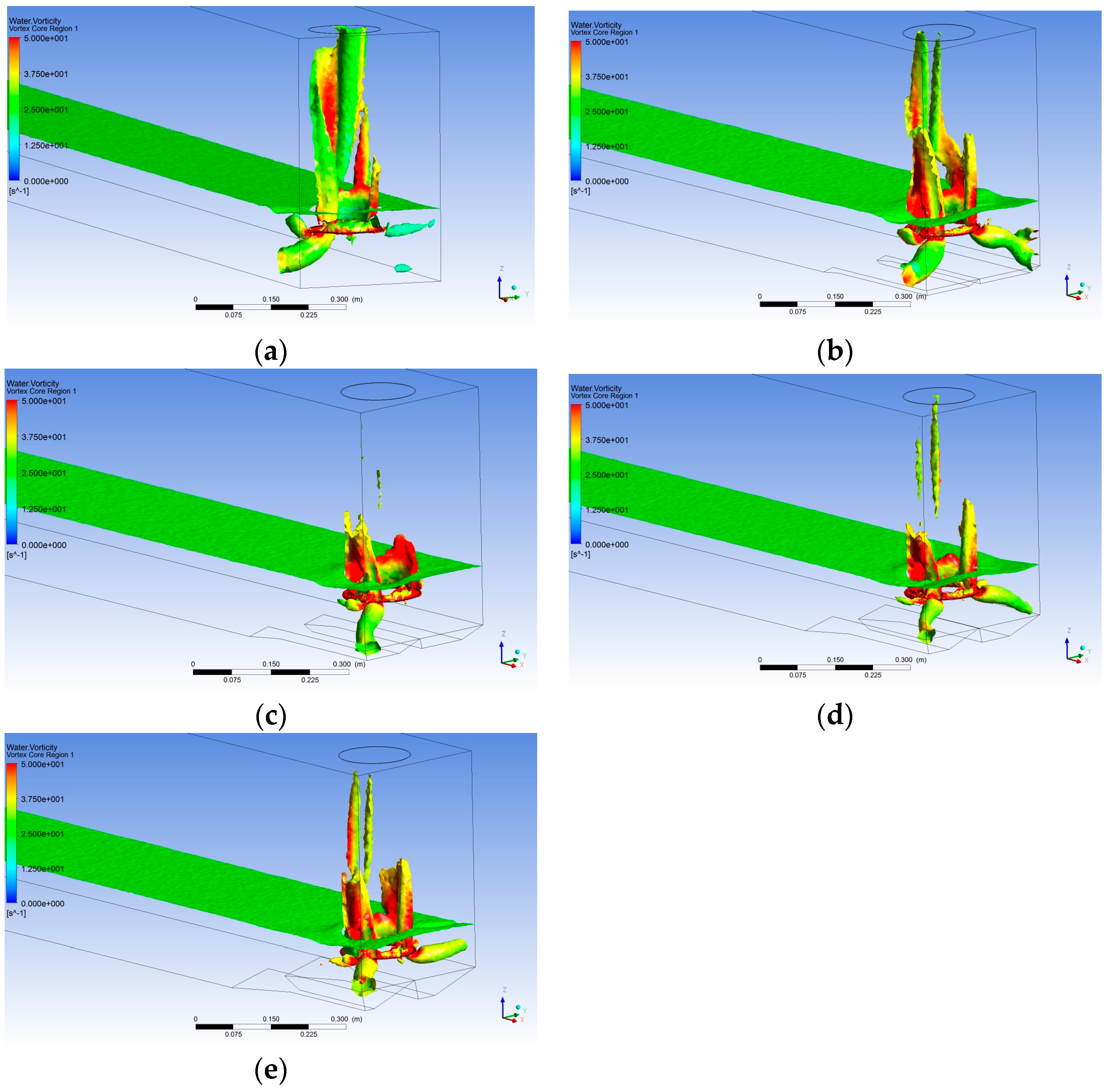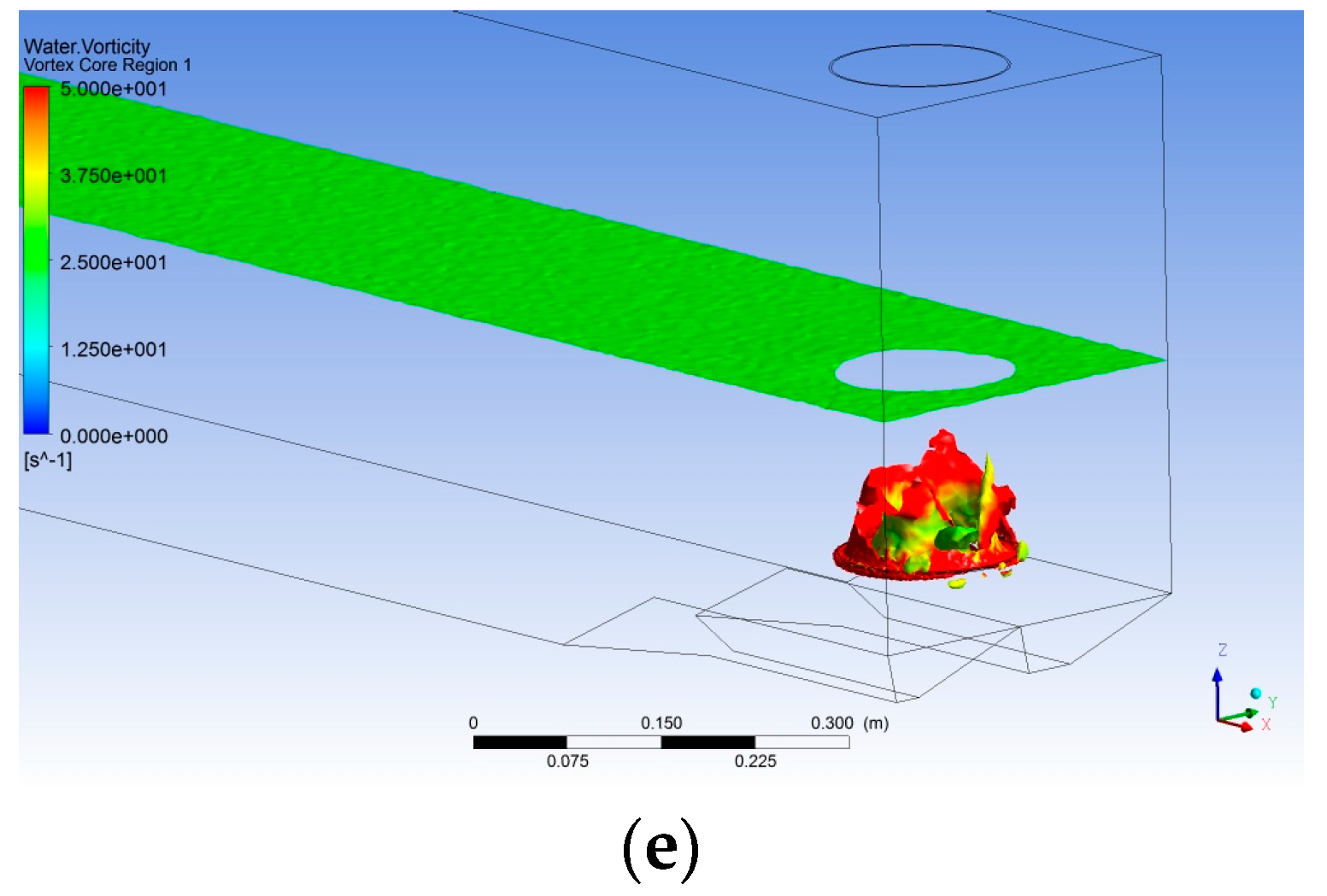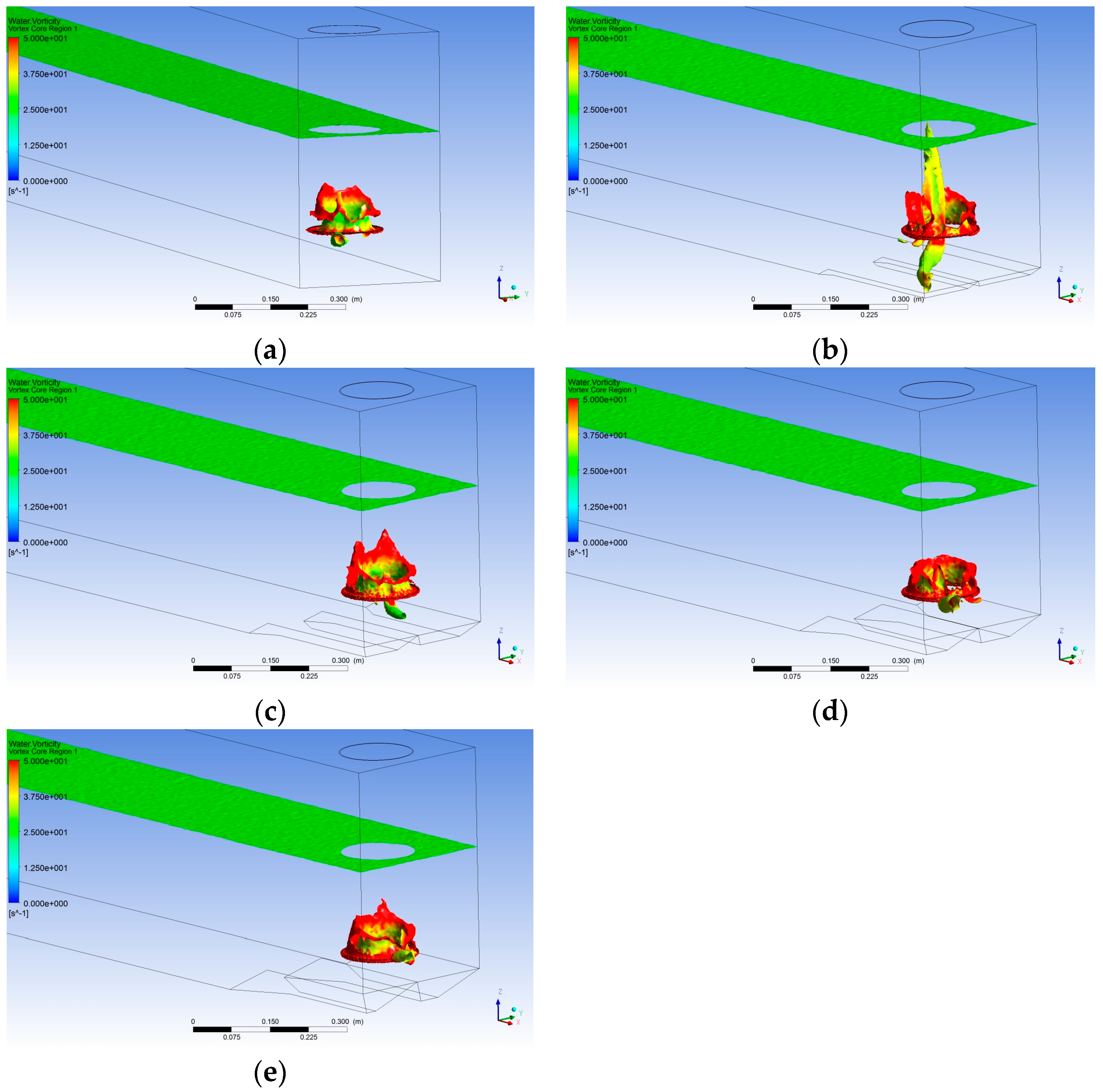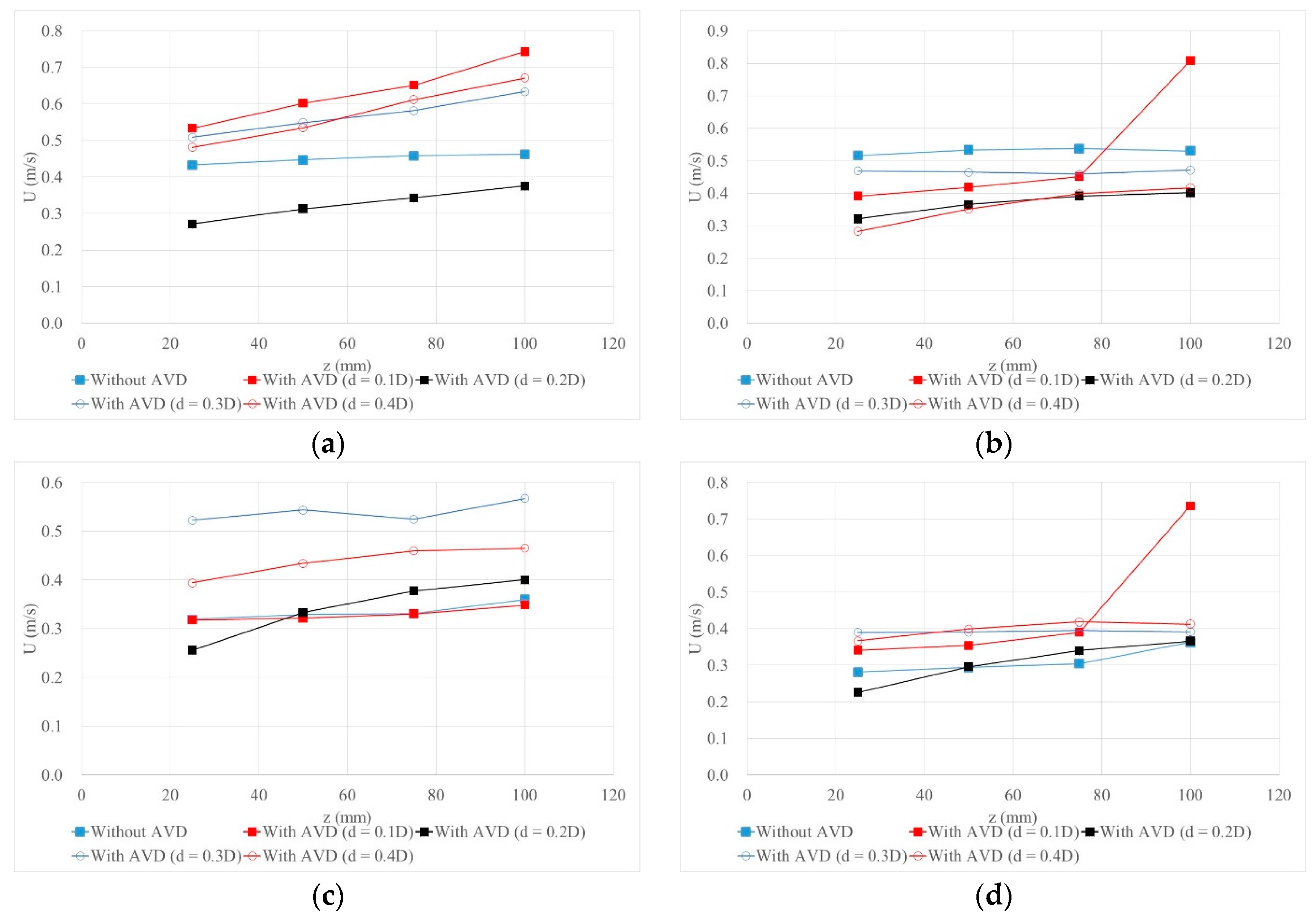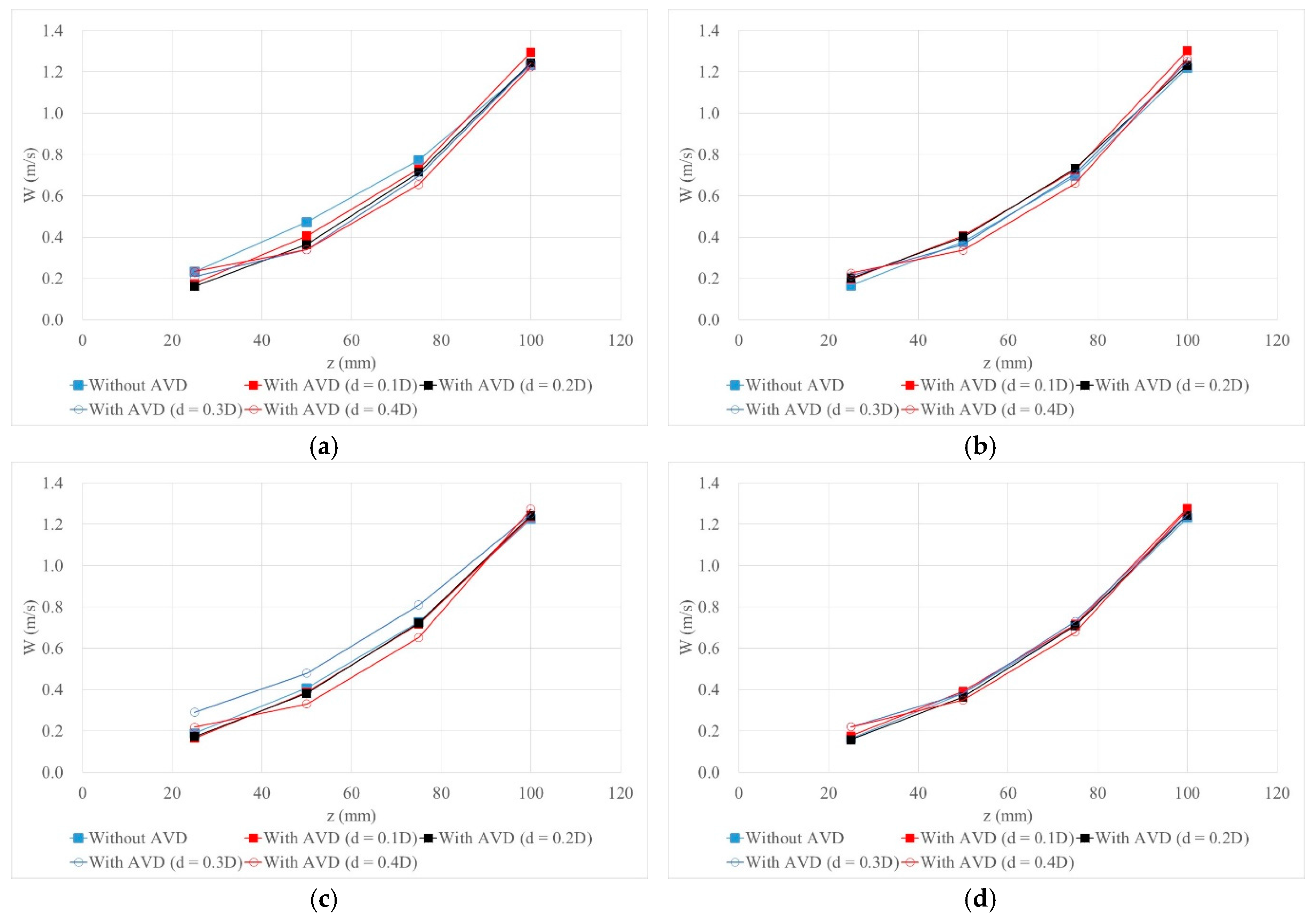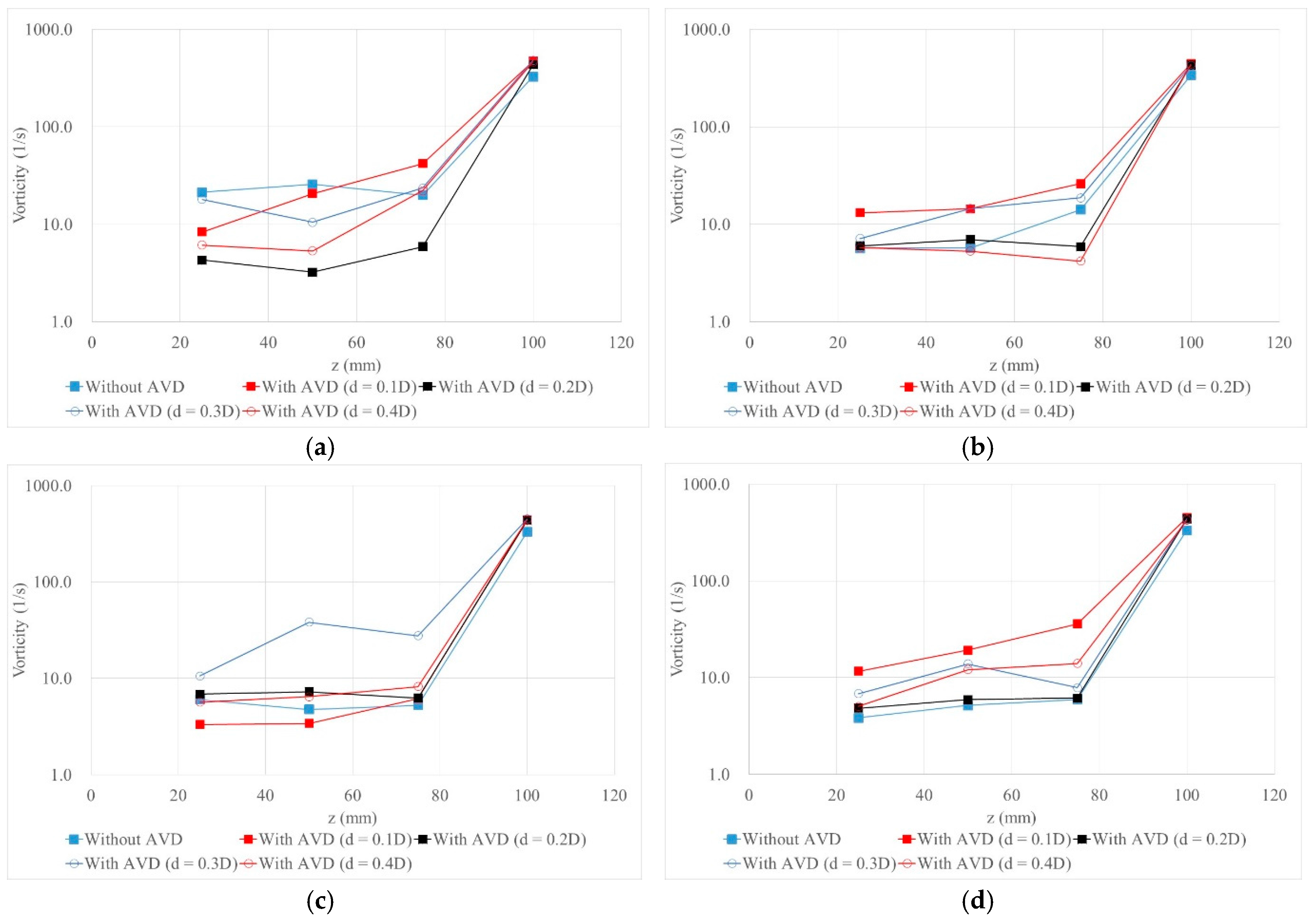3.2. Numerical Results
To analyze the effectiveness of AVD in the pump sump, the change in the flow characteristics of the quantitative and qualitative methods were compared. The vortex core was visualized and compared to illustrate the danger area (i.e., the area with high strength vorticity). A vortex can be defined as either a region or a line. Generally, line-based algorithms provide more compact representations of vortices and can easily distinguish between individual vortices in close proximity [
18]. In this study, the helicity method reported by Levy et al. [
19] was adopted to analyze the vorticity in the pump sump.
Figure 5 shows the analyzed vortex zones under different AVD height conditions in a pump sump with an inflow depth of 0.15 m. The vortex core developed the near channel wall and affected flow in the outlet pipe. However, with variation in AVD height, the formed vortex region changed. The vortex region was minimized for AVD height
d = 0.2
D under the 0.15-m inflow depth condition. With further increase in AVD height, the vortex region becomes larger (
Figure 6,
Figure 7 and
Figure 8).
The changes in the flow velocity and vorticity were quantitatively compared along the four lines listed in
Table 2. The chosen four lines are located under the bell mouth center along the
y-axis, and the heights of lines are 25, 50, 75, and 100 mm from channel bottom. The comparison lines location were determined to analyze flow characteristic changes along the depth beneath the bell mouth center where is the most effective area for pump capacity.
Figure 9 shows the numerical results of
x-directional velocities along the four comparison lines under the numerical cases listed in
Table 1.
Figure 9a shows the numerical simulation results with the lowest inflow depth of
H = 0.15 m. In all of the cases with AVD installations, the calculated velocities were compared with those in the no AVD case. It seemed that the decreased flow area due to AVD installation increased the approach velocity in the front of the bell mouth. However, when AVD height was 0.2
D, the flow velocity decreased as depicted in
Figure 9a.
Figure 9b shows the numerical simulation results at the inflow depth of
H = 0.20 m. In general, the flow velocity was reduced by the installed AVD. However, when the AVD height was 0.1
D, the flow velocity near the bell mouth abruptly increased. It can be surmised that the inappropriate AVD height affects the approach flow streamline and causes a severe direction change.
Figure 9c depicts the calculated
x-directional velocity results under the numerical cases with an inflow depth of
H = 0.25 m. When the AVD was present, it derived the increased flow velocity results. It showed the decrease in the flow velocity results only at the lowest comparison line with AVD of height 0.2
D. It can be surmised that the bottom splitter changed the flow directions and the velocity in
x-direction near channel bottom decreased and that of the upper area around the bell mouth increased.
Figure 9d shows the numerical results with the deepest inflow depth of
H = 0.30 m. When the AVD was installed in the sump, the flow velocity along the
x-axis increased in general. However, when the installation height was 0.2
D, the flow velocity near the channel bottom was decreased. Furthermore, when the AVD height was 0.1
D, the flow velocity near the bell mouth abruptly increased. It can be surmised that the appropriate AVD height may decrease approach flow velocity similar to the AVD height
d = 0.2
D case, but if the AVD height is not appropriate the flow velocity may increase considerably around the bell mouth, as shown in the case of AVD height
d = 0.1
D.
Figure 10 shows the numerical results of the maximum
y-directional velocities on the four comparison lines.
Figure 10a shows the numerical results with the lowest inflow depth of
H = 0.15 m. The calculated velocities generated similar value with the case without AVD installation, except the AVD height is
d = 0.1
D between the z is from 50 mm to 75 mm. In this region, the result for the case with AVD height
d = 0.2
D show slightly decreased velocity in the
y-direction. In all cases, AVD installation derived velocity increase. It seems that the decreased flow area due to AVD installation may worsen flow characteristics near the bell mouth. It shows the increased flow velocity consistently with the AVD height
d = 0.1
D. Thus, it can be surmised that the AVD height is insufficient to control flow characteristics in the pump sump, and AVD may cause unintended flow condition changes.
Figure 10b shows the numerically calculated
y-directional flow velocities for the AVD installation case with inflow depth of
H = 0.20 m. Very similar velocity distributions were obtained in most cases, and the calculated flow velocity is found to be slightly lower for AVD height
d = 0.2
D between
z = 25 mm and 0.75 mm. However, the flow velocity was higher when the AVD height was 0.1
D, similar to the results of inflow depth
H = 0.15 m case. Increased velocity results are observed at
z = 100 mm lines where the bell mouth is located.
Figure 10c depicts the calculated
y-directional velocity results under the numerical cases with inflow depth of
H = 0.25 m conditions.
As shown in
Figure 10c, the installation of AVD did not make a significant difference in velocity calculations, except in the case of AVD height of
d = 0.3
D in the region of
z-direction from 25 mm to 75 mm. However, it showed increased velocity calculation results near the bell mouth in all AVD installation cases.
Figure 10d shows a comparison of the numerical results of
y-directional velocity with the deepest inflow depth of
H = 0.30 m. It was observed that the AVD installation causes a slight velocity increase from
z = 25 mm to 75 mm, except in the case of AVD height
d = 0.2
D. The maximum velocity increase was observed in the case of AVD height
d = 0.1
D. In all AVD installation cases, a velocity increase was observed on the bell mouth height. In the numerical results comparisons of the
y-directional velocity change, the velocity was observed to increase owing to AVD installation around the bell mouth height. It is surmised that the velocity decrease by AVD installation cannot be expected in all areas in the pump sump, and unexpected flow velocity increase may occur near the bell mouth.
Figure 11 shows a comparison of
z-directional velocity changes by AVD installation.
Figure 11a shows the numerical simulation results with the lowest inflow depth of
H = 0.15 m. In the overall cases with AVD installations, only a slight decrease in velocity was observed. The velocity decrease was distinctly observed between
z = 50 mm and 75 mm areas. Very similar velocity calculation results were observed near the bell mouth height, but little velocity increase is expected with an installation of AVD height
d = 0.1
D.
Figure 11b depicts the numerical results of the
z-directional velocity with an inflow depth of
H = 0.20 m. In all of the cases, no significant velocity change was observed. This means that AVD installation cannot affect the
z-directional velocity in all cases.
Figure 11c shows the comparison of maximum
z-directional velocity on the comparison lines with an inflow depth of
H = 0.25 m. In the cases of the AVD height
d = 0.1
D and 0.2
D, no significant velocity changes were observed by numerical simulations. However, velocity increase was observed for the installation of the 0.3
D height AVD, and a velocity decrease was observed for the installation of the 0.4
D height AVD. The velocity change is evident between
z = 50 mm and 75 mm, similar to the results of the case with an inflow depth
H = 0.15 m. It can be surmised that the most effective area for the decrease in the
z-directional velocity owing to AVD installation is the middle region of the bell mouth and channel bottom.
Figure 11d shows the numerical results with the deepest inflow depth of
H = 0.30 m. No significant flow velocity changes could be observed in this case.
The main purpose of AVD installation is to decrease vorticity in a pump sump. Thus, the vorticity change analysis is the most important in AVD studies. The numerically-calculated vorticities on the four comparison lines were compared with test cases and are shown in
Figure 12.
Figure 12a depicts the resultant vorticity by each case and the decreased vorticities by AVD installation. In particular, the case of AVD height
d = 0.2
D derived the most effective vorticity decrease. However, increased vorticities were observed in the region above
z = 75 mm. It is surmised that the reduced flow area may primarily affect this region as a
y-directional velocity change results.
Figure 12b shows the simulated results of vorticity for the inflow depth of
H = 0.20 m. In cases with AVD height
d = 0.2
D and 0.4
D, decreased vorticity is observed at the
z = 75 mm comparison line and vorticity results similar to the calculated results without AVD installation are obtained. However, the increased vorticities were simulated with the cases of AVD height
d = 0.1
D and 0.3
D.
Figure 12c depicts the calculated vorticity results under the numerical cases with an inflow depth of
H = 0.25 m. When the AVD with height
d = 0.3
D was adopted in the pump sump, severely increased vorticity results were obtained. In most cases, with other AVD height cases, it showed similar results with those of the channel-only test case. This result may imply that inappropriate AVD installation can worsen the flow characteristics with an unexpected vortex.
Figure 12d shows the numerical results with an inflow depth of
H = 0.30 m, which is the deepest condition. In all cases, the calculated vorticities were increased after the installation of AVD in the pump sump. Only in the case of AVD height
d = 0.2
D, the increase of vorticity showed negligible quantities. The greatest vorticity increase was found for the AVD height
d = 0.1
D case. It can be surmised that if the flow characteristics are sufficiently stable, AVD installation may worsen the flow conditions in a pump sump.
The velocity and vorticity changes in each direction along the comparison lines under the numerical test cases of various AVD installation heights were compared. Distinguishable velocity changes were observed in the x-directional velocity comparisons. This implies that the flow area reduction primarily affects the approach direction velocity. As the x-directional flow velocity changes, definite velocity changes are observed in the y-axis. Furthermore, unexpected velocity increases were observed in some cases. This implies that the appropriate AVD height has to be determined in the pump sump design procedure to satisfy varying flow conditions. As seen from the vorticity result comparisons, inappropriate AVD height can worsen flow characteristics in a pump sump. If the pump operation conditions require AVD installation, like with the inflow depth H = 0.15 m and H = 0.20 m cases, the AVD height should be 0.2D.
The results of this study are derived from the first-order numerical scheme for convective and diffusion flow calculations. If the higher-order scheme was applied to the regeneration of pump sump flow, different results about the vortex region and strength may be calculated. Furthermore, only the tetrahedron mesh system was applied in this study. The different mesh systems could derive different numerical results. Thus, additional study about different numerical and mesh systems for pump sumps should be followed to improve the applicability of the present study results. Thus, it seems that the present results are useful to describe the trend about the effectiveness of AVD installations.
